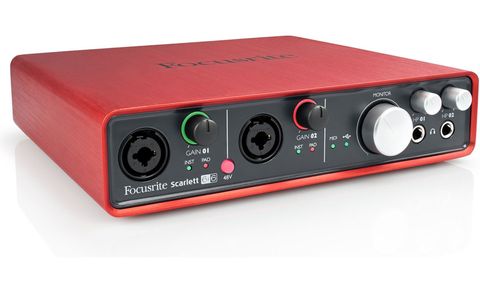Focusrite's Scarlett USB audio interfaces have continued to impress with its most recent flagship 18i20 proving you can get great performance and channel counts via a USB 2.0 connection. The 6i6 we have on the bench for review is the mid range unit, sitting just just above the more compact Scarlett 2i2 and Scarlett 2i4.
There's an older Scarlett interface that delivers similar capabilities (8i6) and although this is still available, as stock runs out the new unit will supersede it.
Up close
The new interface carries the same styling as the 2i2 and 2i4, including the striking red anodised aluminium wraparound case. All physical connections are on the case (so no break out cables) and the unit includes the Scarlett MixControl software.
This handles monitor and output routing as well as global sample rate and sync settings (at up to 24-bit/96kHz). The unit also includes MIDI in and out and is powered via external PSU (note, no USB bus powering), and there are front panel LEDs for both MIDI and USB activity.
"One key aspect of the Scarlett design is the high quality Focusrite analogue pre-amp design"
One key aspect of the Scarlett design is the high quality Focusrite analogue pre-amp design. This offers plenty of clean gain for mic, line and instrument inputs. Switching between mic and line is handled automatically by plug type.
Meanwhile instrument input is selected via MixControl, and here you'll also find a software controlled 10dB pad to reduce hot levels from mic and line sources, and a software gain setting (high or low) for additional analogue inputs.
Rounding things off is the bundled software pack, including Focusrite's Scarlett Plug-in Suite (compressor, EQ, gate, reverb), Ableton Live Lite, Novation Bass Station virtual instrument and LoopMasters sample pack.
Well connected
The 6i6 is pretty simple in terms of its connectivity, with two pre-amp equipped front panel mic/ line/instrument inputs, and two rear mounted balanced TRS line level inputs.
There are four rear mounted balanced TRS outputs, and the six in/ out spec is completed by rear mounted stereo S/PDIF in/out. Finally, the front panel phantom power switch activates power for both mic pre-amps, and the 6i6's main monitor knob controls the level at outputs 1 and 2. There are two headphone outputs with individual level control. These are shared with outputs 1 to 4, but with a separate output pair for each headphone output.
So although the 6i6 is less flexible than models higher up in the range (such as the recent 8i8), as you can't keep your main outputs free from both headphone feeds, it's great to see twin discrete headphone feeds on both units. This perfectly suits modern recording practices, where you're often recording and monitoring in a single room, and both monitoring on headphones.
So how does it stack up?
The unit is very good sonically. Mics sound clear and open with plenty of gain for lower output dynamics and ribbons. Meanwhile, guitars and basses via the instrument input sound solid and uncoloured.
"We would expect plenty of detail from the outputs and that's what you get"
As interfaces go the Scarletts sound very modern, so we would expect plenty of detail from the outputs and that's what you get. You could say it's almost too much, but it means you can monitor at lower levels and still hear plenty of detail - great for mixing.
It may not be that obvious from the pictures, but the 6i6 at 50mm high is over 1U. So, with its rubber feet, its clearly designed for desktop rather than rackmount use.
It feels solidly made and should withstand regular use for a number of years. One interesting feature is input level metering. This has been incorporated into the gain knobs themselves in what Focusrite calls a 'gain halo'. The colour is green when the signal reaches -24dBFS and turns red at 0dBFS. In use, we think an interim colour prior to 0dBFS would also be helpful.
All in all, it's a pretty tidy interface. The 6i6 offers a commonplace six in/six out set-up, albeit with two headphone outs, but we like the way it looks, sounds and behaves and it is priced very competitively.

